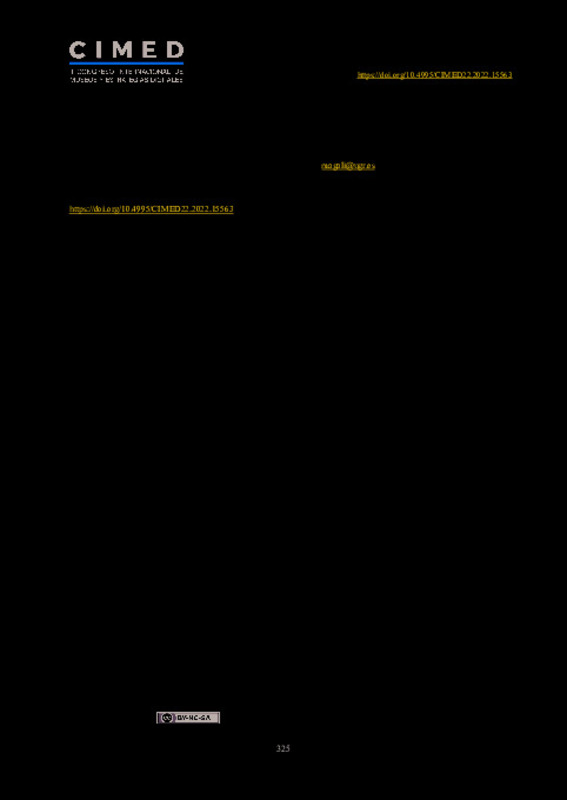JavaScript is disabled for your browser. Some features of this site may not work without it.
Buscar en RiuNet
Listar
Mi cuenta
Estadísticas
Ayuda RiuNet
Admin. UPV
(R)evolución digital de las colecciones universitarias
Mostrar el registro sencillo del ítem
Ficheros en el ítem
| dc.contributor.author | García Lirio, Manuela
|
es_ES |
| dc.date.accessioned | 2022-11-17T08:12:41Z | |
| dc.date.available | 2022-11-17T08:12:41Z | |
| dc.date.issued | 2022-10-25 | |
| dc.identifier.isbn | 9788413960692 | |
| dc.identifier.uri | http://hdl.handle.net/10251/189834 | |
| dc.description.abstract | [EN] To speak of university heritage requires, first of all, to distinguish between university museums and university collections. Regardless of the category in wich it falls, university heritage offers, in turn, a wide variety of typologies that, according to the Committee of Museums and University Collections (UMAC), excedes 90 categories. Although university museums seem to us to be a novel typology within the fild of museology, the truth is that their origin dates back to the 17th century. Although more than 330 years have passed since the creation of the first university museum (Ashmolean Museum, 1683) at the University of Oxford, university museums remain largely unknown, both inside and outside the university academic community. The university heritage has been defined on many occasions as unknown, dispersed, inaccesible and hidden, within the university academic institutions. We continue to find the difficulty, both in accessibility and visibility. This proposal arises after my predoctoral research entitled “University art museums and collections in the Iberoamerican sphere”, focused on a total of 84 examples of university art museums and collections in 49 universities in ten countries: Argentina, Brazil, Chile, Colombia, Ecuador, Spain, Mexico, Portugal, Peru and Venezuela. Through this proposal, I intend to show which are the digital resources that are used for the management and dissemination of university heritage in the Ibero-American sphere. I will specially focus on the artistic. Through this tour we find repositories, inventories and other digital resources such as virtual museums. All these examples share the need to be visible in society to meet the objectives of any other museum typology, thus responding to the definition of a museum. In short, through these resources, it is intended to generate another window of knowledge through digital evolution. | es_ES |
| dc.description.abstract | [ES] Hablar de patrimonio universitario requiere, en primer lugar, distinguir entre museos universitarios y colecciones universitarias. Independientemente de la categoría en la que se encuentre, el patrimonio universitario ofrece, a su vez, una gran variedad de tipologías que según el Comité de Museos y colecciones universitarias (UMAC) supera las 90 categorías. Aunque los museos universitarios nos parezcan una tipología novedosa dentro del ámbito de la museología, lo cierto es que su origen se remonta al siglo XVII. A pesar de que se hayan cumplido más de 330 años desde la creación del primer museo universitario (Ashmolean Museum, 1683) en la Universidad de Oxford, los museos universitarios siguen siendo los grandes desconocidos, tanto dentro como fuera de la comunidad académica universitaria. El patrimonio universitario se ha definido en muchas ocasiones como desconocido, disperso, inaccesible y oculto, dentro de las instituciones académicas universitarias. La dificultad la seguimos encontrando, tanto en la accesibilidad como en la visibilidad. Esta propuesta surge tras mi investigación predoctoral que lleva por título “Museos y colecciones universitarias de arte en el ámbito iberoamericano”, centrado en un total de 84 ejemplos de museos y colecciones universitarias de arte en 49 universidades de diez países: Argentina, Brasil, Chile, Colombia, Ecuador, España, México, Portugal, Perú y Venezuela. A través de esta propuesta, pretendemos mostrar cuales son los recurso digitales que se utilizan para la gestión y difusión del patrimonio universitario en el ámbito iberoamericano. Especialmente nos centraremos en el patrimonio universitario artístico. Mediante este recorrido encontramos repositorios, inventarios y otros recursos digitales como museos virtuales. Todos estos ejemplos comparten la necesidad de ser visibles en la sociedad para cumplir con los objetivos de cualquier otra tipología museística, respondiendo así a la definición de museo. En definitiva, a través de estos recursos, se pretende generar una ventana más de conocimiento a través de la evolución digital. | es_ES |
| dc.format.extent | 12 | es_ES |
| dc.language | Español | es_ES |
| dc.publisher | Editorial Universitat Politècnica de València | es_ES |
| dc.relation.ispartof | CIMED22 - II Congreso internacional de museos y estrategias digitales | |
| dc.rights | Reconocimiento - No comercial - Compartir igual (by-nc-sa) | es_ES |
| dc.subject | Colección | es_ES |
| dc.subject | Museo | es_ES |
| dc.subject | Arte | es_ES |
| dc.subject | Patrimonio universitario | es_ES |
| dc.subject | Iberoamerica | es_ES |
| dc.subject | Collection | es_ES |
| dc.subject | Museum | es_ES |
| dc.subject | Art | es_ES |
| dc.subject | University heritage | es_ES |
| dc.subject | Ibero-American | es_ES |
| dc.title | (R)evolución digital de las colecciones universitarias | es_ES |
| dc.title.alternative | Digital (r)evolution of university collections | es_ES |
| dc.type | Capítulo de libro | es_ES |
| dc.type | Comunicación en congreso | es_ES |
| dc.identifier.doi | 10.4995/CIMED22.2022.15563 | |
| dc.rights.accessRights | Abierto | es_ES |
| dc.description.bibliographicCitation | García Lirio, M. (2022). (R)evolución digital de las colecciones universitarias. En CIMED22 - II Congreso internacional de museos y estrategias digitales. Editorial Universitat Politècnica de València. 325-336. https://doi.org/10.4995/CIMED22.2022.15563 | es_ES |
| dc.description.accrualMethod | OCS | es_ES |
| dc.relation.conferencename | Congreso CIMED - II Congreso Internacional de Museos y Estrategias Digitales | es_ES |
| dc.relation.conferencedate | Octubre 19-28, 2022 | es_ES |
| dc.relation.conferenceplace | Valencia, España | es_ES |
| dc.relation.publisherversion | http://ocs.editorial.upv.es/index.php/CIMED/Cimed22/paper/view/15563 | es_ES |
| dc.description.upvformatpinicio | 325 | es_ES |
| dc.description.upvformatpfin | 336 | es_ES |
| dc.type.version | info:eu-repo/semantics/publishedVersion | es_ES |
| dc.relation.pasarela | OCS\15563 | es_ES |
| dc.contributor.funder | Universidad de Granada | es_ES |








